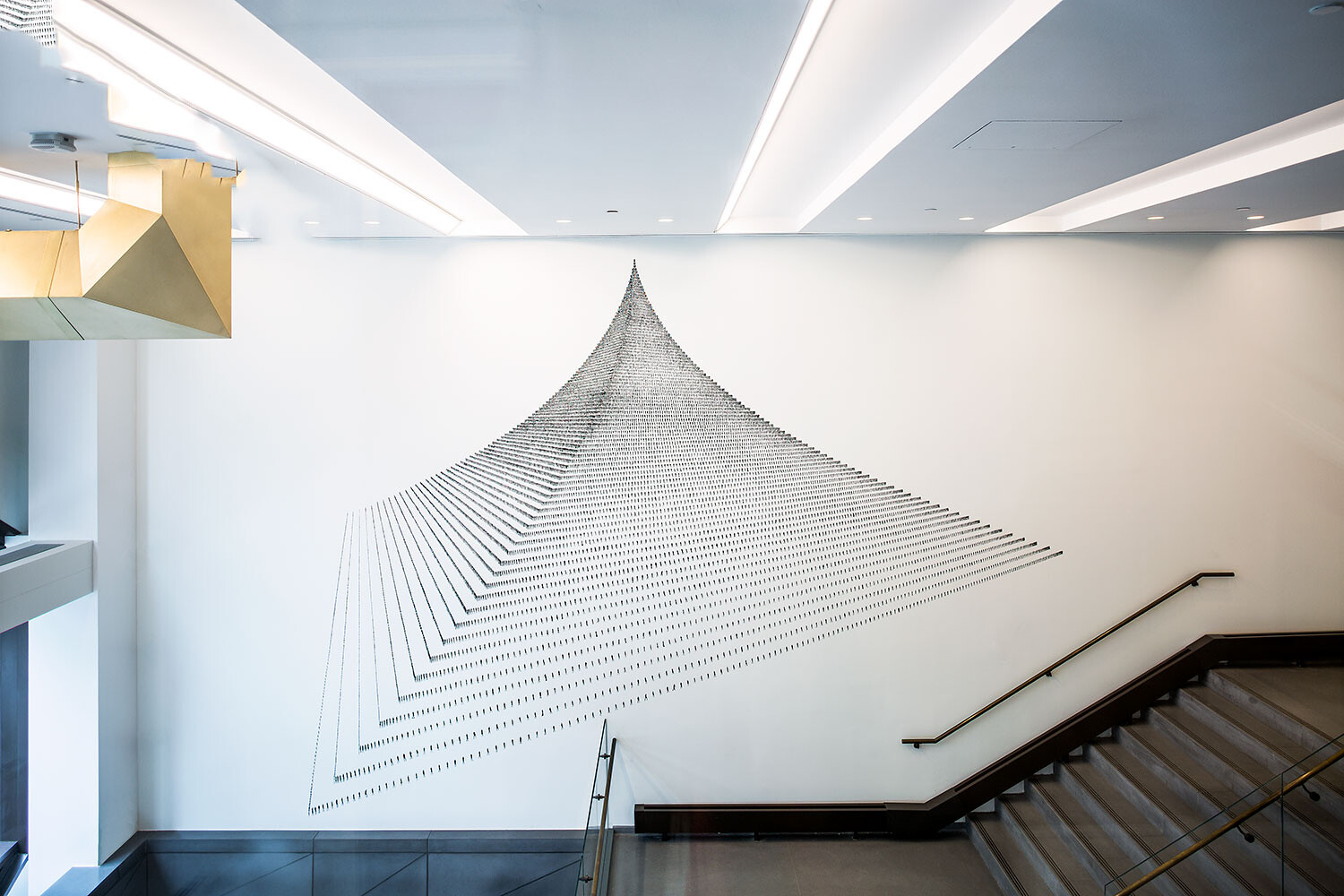The New School is pleased to announce the installation of a permanent site-specific mural by the pioneering artist Agnes Denes. Often associated with the concept-based land artists and early environmental activists of the 1960s and 1970s, Denes is known for her multidisciplinary practice and visionary explorations in philosophy, mathematics, linguistics, science, history, and performance. Now in her 80s, Denes continues to produce timely, ambitious work that is exhibited worldwide. The artist is currently participating in documenta 14 in Athens, Greece (April through July 2017) and Kassel, Germany (June through September 2017).
The New School mural, Pascal’s Perfect Probability Pyramid & the People Paradox – The Predicament, 1980/2016, is based on Denes’ iconic ongoing Pyramid Series. The 18-by-24-foot mural, redesigned and transferred from a drawing completed by the artist in 1980 (in the private collection of Agnes Gund), consists of thousands of human figures forming a pyramid. The mural occupies a double-height wall in the Bernard and Irene Schwartz Commons Dining Hall of The New School’s University Center, located at 63 Fifth Avenue and designed by Skidmore, Owings & Merrill (SOM).
In her 2008 book, The Human Argument, Denes writes that the Pyramid Series and in particular Pascal’s Perfect Probability Pyramid represent “a society composed of individuals who stand in protected isolation, alone but without privacy. They cannot escape the structure; yet they seem fooled by the illusions of freedom. Representing alienation in togetherness and uniqueness in uniformity, they assume the journey of a living paradox.… The magnificence of their collective accomplishments and the insignificance of the individual component are unmistakable. Not a single figure can walk away from the structure—they are the structure. They are the anatomy and the form and it is their illusions of freedom and the inescapability of the system that form the ultimate paradox.”
Denes is best known for her 1982 work Wheatfield – A Confrontation. Considered by Guggenheim curator Jeffrey Weiss “one of Land Art’s great transgressive masterpieces,” this poetic gesture, situated in the shadow of the World Trade Center, challenged the capitalist ambitions of the NYC downtown landscape. Wheatfield was fully realized at the height of the Russian wheat embargo, as the recession of the 1970s gave way to the prosperity of the following decade. This single, elegant work raises complex questions—which continue to resonate—about land use, food production, population growth, migration, labor, power structures, and human engagement with the natural world.
Denes has created other ambitious earthworks including Tree Mountain — A Living Time Capsule, 1996, a conifer forest in Finland; and A Forest for Australia, 1998, native saplings planted in the form of five spiraling steps in Melbourne. Most recently, Denes was commissioned in 2015 to create The Living Pyramid for the Socrates Sculpture Park in Long Island City, New York. Also in 2015, Wheatfield was re-created on a 12-acre site in Milan, Italy, with the support of the Nicola Trussardi Foundation.
Born in Hungary in 1931, raised in Sweden, and educated in the United States, Agnes Denes has participated in more than 500 solo and group exhibitions at galleries and museums around the world, including international surveys such as the Biennale of Sydney (1976); documenta 6, Kassel, Germany (1977); the Venice Biennale (1978, 2001, 2003). Denes is a Guggenheim Fellowship recipient and has received numerous other fellowships and awards including the DAAD Fellowship, Berlin, Germany (1978); MIT’s Eugene McDermott Achievement Award “In Recognition of Major Contribution to the Arts” (1990); and the Rome Prize from the American Academy in Rome (1998).
Agnes Denes is represented by Leslie Tonkonow Artworks + Projects, New York. Her fifth solo exhibition with the gallery will open in fall, 2017. Along with her participation in documenta 14 in Athens, Greece and Kassel, Germany (April through September 2017), works by the artist will also be included in the ARoS Triennial, ARoS Aarhus Kunstmuseum, Denmark (April 8 through September 10, 2017); Urban Planning: Contemporary Art and the City 1966–2017, Contemporary Art Museum, St. Louis (May 5 through August 13, 2017); and Delirious: Art at the Limits of Reason, 1950–1980, The Met Breuer, New York (September 12, 2017 through January 14, 2018).
About The New School Art Collection
The university has a long-standing tradition of supporting the creation of new art in public spaces. This initiative began in 1931 with the opening of the university’s landmark building at 66 West 12th Street, designed by Joseph Urban, and the commissioning of works by Mexican artist José Clemente Orozco, American artist Thomas Hart Benton, and Ecuadorian artist Camilo Egas. In addition to the Agnes Denes mural, recent commissions include site-specific works by Glenn Ligon, Alfredo Jaar, and Rita McBride as well as earlier commissioned works by Sol LeWitt, Kara Walker, Brian Tolle, Martin Puryear and Michael Van Valkenburgh, Dave Muller, and Gonzalo Fonseca. The New School Art Collection, now curated by Silvia Rocciolo and Eric Stark, was established in 1960 with a grant from the Albert A. List Foundation. For more information, please visit newschool.edu/artcollection.

